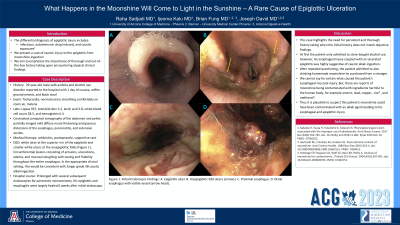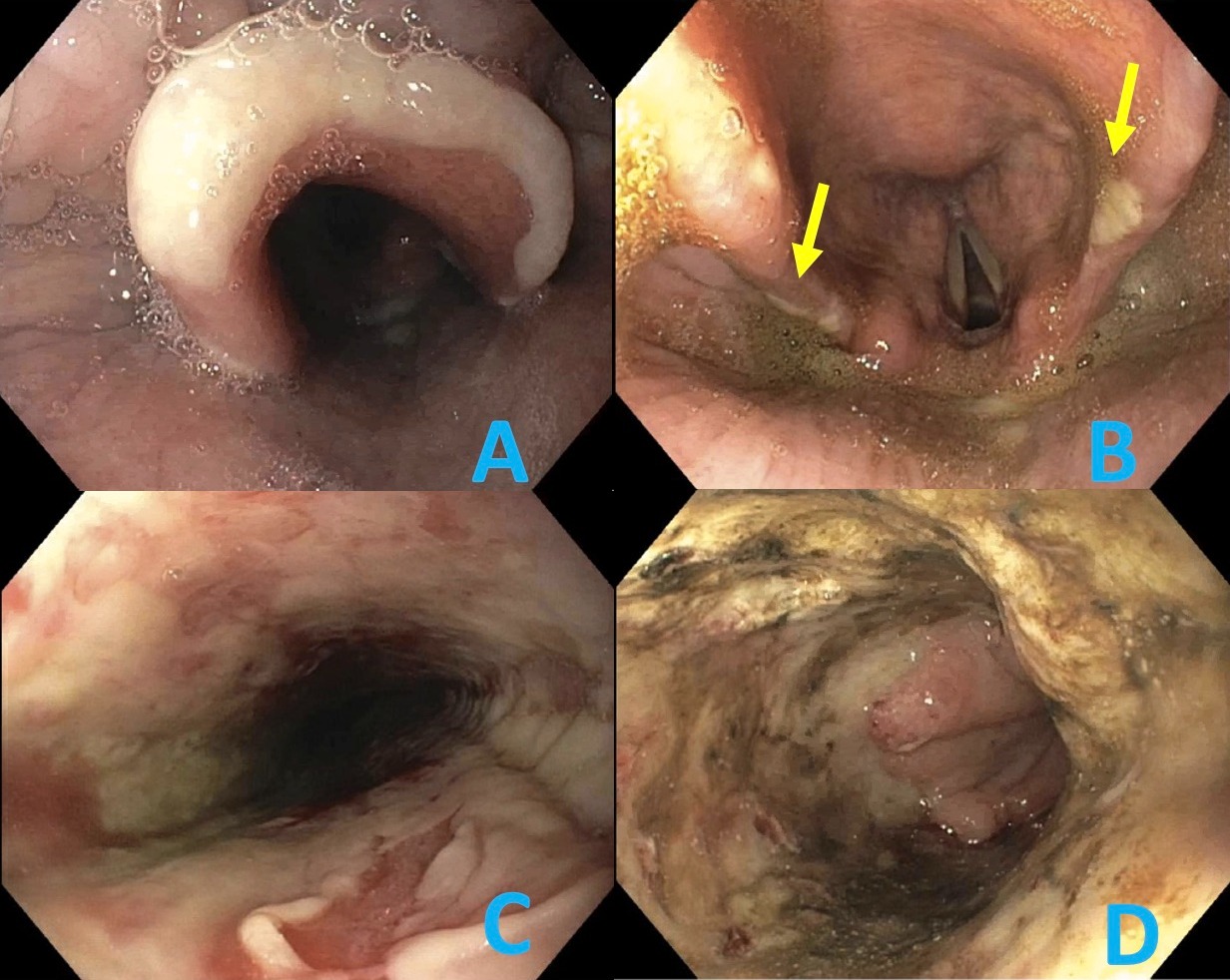Sunday Poster Session
Category: Esophagus
P0515 - What Happens in the Moonshine Will Come to Light in the Sunshine – A Rare Cause of Epiglottic Ulceration
Sunday, October 22, 2023
3:30 PM - 7:00 PM PT
Location: Exhibit Hall

Has Audio

Raha Sadjadi, MD
University of Arizona College of Medicine
Phoenix, AZ
Presenting Author(s)
Raha Sadjadi, MD, IJeoma Kalu, MD, Brian M.. Fung, MD, Joseph David, MD
University of Arizona College of Medicine, Phoenix, AZ
Introduction: The etiology of epiglottic injury is vast and includes infectious, autoimmune, drug induced, and caustic exposures. Here, we present a unique cause of caustic injury to the epiglottis and esophagus: moonshine ingestion. We aim to emphasize the importance of thorough and out-of-the-box history taking upon encountering atypical clinical findings.
Case Description/Methods: A 29-year-old male with asthma and alcohol use disorder presented to the hospital with 1 day of nausea, coffee ground emesis, and melena. He was tachycardic, but normotensive and breathing comfortably on room air. Melena was found on exam. His lipase was 937, total bilirubin 3.2, lactic acid 2.8, white blood cell count 28.5, and hemoglobin 6.4. He was started on antibiotics and pantoprazole. Computed tomography of the abdomen and pelvis with contrast showed partially imaged mild diffuse mural thickening and gaseous distension of the esophagus, pancreatitis, and extensive ascites. Upper endoscopy showed a white ulcer at the superior rim of the epiglottis and smaller white ulcers at the aryepiglottic folds (Figure 1). Circumferential lesions consisting of erosions, ulcerations, edema, and mucosal sloughing with oozing and friability was noted throughout the entire esophagus. In the appropriate clinical setting, this would be consistent with Zargar grade IIB caustic alkali ingestion. The patient had a prolonged hospital stay and underwent several subsequent endoscopies for pancreatic necrosectomy. His epiglottis and esophagitis were largely healed 6 weeks after initial endoscopy. Upon further questioning, the patient reported drinking moonshine on several occasions over the past 3 months.
Discussion: This case highlights the need for persistent and thorough history taking when the initial history does not match objective findings. At first the patient only admitted to alcohol use. However, his esophageal injury coupled with an ulcerated epiglottis was highly suggestive of caustic alkali ingestion. After repeated questioning, the patient admitted to also drinking homemade moonshine he purchased from a stranger. We cannot say for certain what caused the patient’s esophageal mucosal injury. But, there are reports of moonshine being contaminated with ingredients harmful to the human body; for example arsenic, lead, and methanol. Thus it is plausible to suspect this patient’s moonshine could have been contaminated with an alkali agent leading to his esophageal and epiglottic injury.

Disclosures:
Raha Sadjadi, MD, IJeoma Kalu, MD, Brian M.. Fung, MD, Joseph David, MD. P0515 - What Happens in the Moonshine Will Come to Light in the Sunshine – A Rare Cause of Epiglottic Ulceration, ACG 2023 Annual Scientific Meeting Abstracts. Vancouver, BC, Canada: American College of Gastroenterology.
University of Arizona College of Medicine, Phoenix, AZ
Introduction: The etiology of epiglottic injury is vast and includes infectious, autoimmune, drug induced, and caustic exposures. Here, we present a unique cause of caustic injury to the epiglottis and esophagus: moonshine ingestion. We aim to emphasize the importance of thorough and out-of-the-box history taking upon encountering atypical clinical findings.
Case Description/Methods: A 29-year-old male with asthma and alcohol use disorder presented to the hospital with 1 day of nausea, coffee ground emesis, and melena. He was tachycardic, but normotensive and breathing comfortably on room air. Melena was found on exam. His lipase was 937, total bilirubin 3.2, lactic acid 2.8, white blood cell count 28.5, and hemoglobin 6.4. He was started on antibiotics and pantoprazole. Computed tomography of the abdomen and pelvis with contrast showed partially imaged mild diffuse mural thickening and gaseous distension of the esophagus, pancreatitis, and extensive ascites. Upper endoscopy showed a white ulcer at the superior rim of the epiglottis and smaller white ulcers at the aryepiglottic folds (Figure 1). Circumferential lesions consisting of erosions, ulcerations, edema, and mucosal sloughing with oozing and friability was noted throughout the entire esophagus. In the appropriate clinical setting, this would be consistent with Zargar grade IIB caustic alkali ingestion. The patient had a prolonged hospital stay and underwent several subsequent endoscopies for pancreatic necrosectomy. His epiglottis and esophagitis were largely healed 6 weeks after initial endoscopy. Upon further questioning, the patient reported drinking moonshine on several occasions over the past 3 months.
Discussion: This case highlights the need for persistent and thorough history taking when the initial history does not match objective findings. At first the patient only admitted to alcohol use. However, his esophageal injury coupled with an ulcerated epiglottis was highly suggestive of caustic alkali ingestion. After repeated questioning, the patient admitted to also drinking homemade moonshine he purchased from a stranger. We cannot say for certain what caused the patient’s esophageal mucosal injury. But, there are reports of moonshine being contaminated with ingredients harmful to the human body; for example arsenic, lead, and methanol. Thus it is plausible to suspect this patient’s moonshine could have been contaminated with an alkali agent leading to his esophageal and epiglottic injury.

Figure: Figure 1. Initial Endoscopic Findings: A. Epiglottic ulcer. B. Aryepiglottic fold ulcers (arrows). C. Proximal esophagus. D. Distal esophagus.
Disclosures:
Raha Sadjadi indicated no relevant financial relationships.
IJeoma Kalu indicated no relevant financial relationships.
Brian Fung indicated no relevant financial relationships.
Joseph David indicated no relevant financial relationships.
Raha Sadjadi, MD, IJeoma Kalu, MD, Brian M.. Fung, MD, Joseph David, MD. P0515 - What Happens in the Moonshine Will Come to Light in the Sunshine – A Rare Cause of Epiglottic Ulceration, ACG 2023 Annual Scientific Meeting Abstracts. Vancouver, BC, Canada: American College of Gastroenterology.
